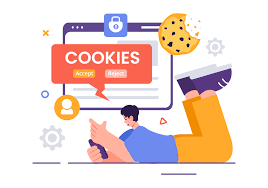Technology
Cookieless Analytics: How to Get Started with Cookieless Tracking
Published
2 months agoon
By
Sky Bloom IT
Cookies have been the backbone of digital tracking for more than two decades. They helped marketers understand user behavior, optimize ads, and personalize experiences. But in 2025, that era is ending. With privacy laws tightening and browsers phasing out third-party cookies, businesses face a critical challenge: how do we keep tracking performance and engagement without breaking compliance or user trust?
This is where cookieless analytics steps in. Instead of relying on invasive tracking scripts, cookieless methods focus on first-party data, server-side tracking, and privacy-friendly alternatives. For brands, this isn’t just a technical adjustment, it’s a strategic shift. Done right, cookieless analytics ensures you still have accurate, actionable insights while staying ahead of regulations and user expectations.
What is Cookieless Analytics?
Cookieless analytics is the practice of tracking and measuring website or app performance without using third-party cookies. Instead of dropping identifiers that follow users across sites, it relies on methods that respect privacy while still providing valuable insights.
Key elements of cookieless analytics include:
- First-party data – Information you collect directly from your users (like form submissions, purchases, or account activity).
- Server-side tracking – Data processing handled on secure servers instead of browsers, reducing dependency on client-side cookies.
- Fingerprinting alternatives – Privacy-friendly signals such as device type, session IDs, and anonymized interactions.
- Consent-driven tracking – Analytics that adapt based on user permissions under GDPR, CCPA, and other data laws.
In simple terms, cookieless analytics shifts control back to businesses and users. Companies gain accurate data tied directly to their properties, while visitors enjoy more transparency and trust.
How Cookieless Tracking Works (Key Approaches) Cookieless tracking doesn’t mean the end of analytics—it means smarter, privacy-conscious methods. Here are the main approaches businesses are adopting in 2025:
First-Party Data Collection Instead of depending on third-party cookies, brands rely heavily on data collected directly from their websites or apps. This includes purchases, email sign-ups, and in-app actions. For example, an eCommerce brand using Shopify analytics can gain a complete picture of customer journeys without intrusive third-party trackers.
Server-Side Tracking With server-side setups, tracking happens behind the scenes on secure servers rather than in the browser. This makes data harder to block and ensures compliance with privacy laws. It also means businesses can maintain reliable reporting even as browsers tighten restrictions.
Contextual and Behavioral Signals Instead of following users across the web, contextual analytics focuses on what’s happening on the page itself such as content viewed, time spent, and interactions made. Paired with AI customer messaging platforms, businesses can personalize conversations in real-time while still staying compliant.
Consent-Based Frameworks Modern analytics tools automatically adapt tracking depending on the permissions users provide. This creates transparency and strengthens user trust, while still giving businesses actionable insights.
Benefits of Cookieless Analytics
Adopting cookieless analytics isn’t just about compliance it unlocks advantages that align with modern marketing. Below are key benefits you can gain:
1. Stronger User Trust & Privacy Compliance
When users know you’re not silently tracking them across the web, trust increases. Cookieless analytics aligns with regulations like GDPR, CCPA, and emerging privacy laws, reducing the risk of fines or backlash.
2. Cleaner, More Reliable Data
Third-party cookies are often blocked or deleted. Cookieless approaches especially server-side tracking capture data more consistently. This means fewer gaps, fewer “unknowns,” and more dependable reports.
3. Future-Proof Analytics
Browsers are phasing out support for third-party cookies (Chrome, Safari, etc.). By going cookieless now, you stay ahead of the curve instead of scrambling later. Your analytics won’t break when the next browser update drops.
4. Better Attribution & Conversion Insights
With first-party data and server-side tracking, you can more accurately link campaigns to conversions. Especially if you’re using Shopify analytics, combining purchase events with on-site behavior gives you a fuller view of the user path.
5. Smarter Real-Time Personalization
Cookieless tracking paired with tools like AI customer messaging lets you respond to user behavior on the fly without violating privacy rules. For instance: if your analytics detects hesitation on a pricing page, your messaging bot could trigger a helpful nudge or offer.
6. Reduced Reliance on Scripts & Page Load Overhead
Cookie-heavy scripts slow down pages and risk being blocked. Cookieless methods especially server-side and lightweight event collection minimize client-side load, improving performance and user experience.
How to Start Cookieless Tracking (Step-by-Step)
Switching to cookieless analytics may sound technical, but it’s straightforward if you follow a plan. Here’s how to get started:
1. Audit Your Current Analytics Setup
- List all the tools currently collecting data (Google Analytics, Shopify analytics, ad pixels, etc.).
- Identify which ones depend heavily on third-party cookies.
2. Define Your First-Party Data Sources
- Website traffic (on-site clicks, scrolls, form submissions).
- Shopify analytics for purchases and customer journeys.
- Email engagement data from your CRM.
- Direct survey or preference data from users.
3. Set Up Server-Side Tracking
- Implement tracking on your own server instead of the browser.
- Tools like Google Tag Manager Server-Side or Segment can help.
- This ensures more reliable data capture while respecting privacy rules.
4. Integrate Cookieless Analytics Tools
- Tools like Plausible, Fathom, or Matomo work without cookies.
- They provide simple dashboards with privacy-friendly insights.
- For eCommerce, pair them with Shopify analytics to close the loop on sales data.
5. Test & Validate Data Accuracy
- Compare old cookie-based reports with your new cookieless dashboards.
- Track discrepancies and fine-tune your server-side setup.
6. Connect Insights to Engagement Tools
- Sync cookieless analytics with your AI customer messaging platform.
- Use this to trigger contextual messages (welcome offers, cart recovery nudges) based on first-party signals instead of cookies.
7. Educate Your Team & Customers
- Train your marketing team on how to read cookieless reports.
- Share privacy updates with customers—this transparency builds trust.
Best Cookieless Analytics Tools for 2025
If you’re ready to make the switch, here are some of the top platforms leading the cookieless analytics movement:
1. Seline Analytics
Seline Analytics is a privacy-first analytics platform designed for teams that value simplicity and clarity. Instead of overwhelming you with endless charts, it highlights the metrics that matter most — traffic, engagement, and revenue. What sets Seline apart is its conversational interface: you can literally chat with your analytics by asking natural questions like “How many visitors came from Google last week?” or “Which channel brought in the most paying customers?” and get instant, plain-English answers.
With direct Stripe integration, Seline lets you connect your revenue data to your website performance, making it easy to identify which channels actually drive sales. It’s fully GDPR-compliant, cookie-free, and built with user privacy in mind. You can start free and only pay as your traffic grows.
In short, Seline Analytics keeps analytics simple, smart, and privacy-focused — ideal for e-commerce brands, startups, and teams that want powerful insights without the noise.
2. Plausible Analytics
A lightweight, open-source alternative to Google Analytics. Plausible is fast, transparent, and gives you all the essentials without cookies. It’s especially popular among startups and content-driven websites.
3. Fathom Analytics
Fathom focuses on simplicity and compliance. It provides real-time traffic stats without tracking individuals and is fully GDPR, CCPA, and PECR compliant.
4. Matomo (Self-Hosted Option)
Matomo is an enterprise-grade analytics tool that can be hosted on your own servers. This gives you complete control over your data and eliminates dependency on third-party cookies.
5. Simple Analytics
As the name suggests, Simple Analytics offers easy-to-read dashboards with no tracking cookies, making it a great choice for small businesses and agencies.
Conclusion
The cookieless future isn’t something to fear, it’s an opportunity to build stronger, more transparent relationships with your audience. By leaning on first-party data, embracing tools that don’t rely on invasive tracking, and pairing insights with smart solutions like Shopify analytics and AI customer messaging, your business can still thrive without cookies.
The key is to start now. Audit your setup, test new tools, and educate your team so the transition feels seamless. Privacy-first marketing isn’t just about compliance—it’s about future-proofing your brand in a world where trust is the real currency.
Ready to take action? Begin testing a cookieless analytics tool this week and see how much cleaner and more reliable your data becomes. The earlier you adapt, the more competitive you’ll be in 2025 and beyond.
You may like


Why Did Apple Pull Advanced Data Protection in the UK: What’s Actually Going On?

Study Smarter: How Next-Generation Online Education Delivers Real-World Results

Top 5 Market Research Firms in the UK

The Impact of AI on Modern Financial Decision-Making

How Students Can Stay Connected During Study Abroad and Gap Year Adventures

Bridging the Gap Between Innovation and Real-World Project Delivery

Silent Engines of Industry: The Lifeblood Behind Every Machine

Upgrade Your Bedroom with Custom Wardrobes Made for You

A Winter Market Snapshot: Sittingbourne Buyer Demand and Pricing Trends

Graffitifun graffiti workshops: creative teambuilding and outings redefined

Carol Kirkwood’s Journey: Her Real Age, Husband, Career, and More

Revolutionizing Healthcare: The Emergence of AI-Driven Analytics

How Machine Learning and AI are Redefining the Future?

Aliza Barber: Meet Lance Barber’s Wife, Age, Life, Profile, Career and Net Worth

Evelyn Melendez: Jordan Knight’s Wife Bio, Marriage, Family, Career and Net Worth

Ilan Tobianah Biography: Family, Marriage, Lifestyle, Career and Net Worth

Who was Alice Marrow? Everything to Know About Ice-T’s and His Mother

King Von’s Autopsy Report: The Truth Behind the Tragic Death

Meet Otelia Cox: The Supportive Wife of Tony Cox – A True Fairy Tale Romance

Tea Leoni and Tim Daly Split – A Closer Look at Their Relationship and Breakup

Why Did Apple Pull Advanced Data Protection in the UK: What’s Actually Going On?

Study Smarter: How Next-Generation Online Education Delivers Real-World Results

Top 5 Market Research Firms in the UK

The Impact of AI on Modern Financial Decision-Making

How Students Can Stay Connected During Study Abroad and Gap Year Adventures

Bridging the Gap Between Innovation and Real-World Project Delivery

Silent Engines of Industry: The Lifeblood Behind Every Machine

Upgrade Your Bedroom with Custom Wardrobes Made for You

A Winter Market Snapshot: Sittingbourne Buyer Demand and Pricing Trends

Graffitifun graffiti workshops: creative teambuilding and outings redefined
Category
Trending
-

 News3 months ago
News3 months agoCarol Kirkwood’s Journey: Her Real Age, Husband, Career, and More
-

 Health2 years ago
Health2 years agoRevolutionizing Healthcare: The Emergence of AI-Driven Analytics
-

 Technology2 years ago
Technology2 years agoHow Machine Learning and AI are Redefining the Future?
-

 Celebrity2 years ago
Celebrity2 years agoAliza Barber: Meet Lance Barber’s Wife, Age, Life, Profile, Career and Net Worth
